Fourth International Conference on Computational Methods and Experiments in Materials Characterisation
New Forest, UK
Overview
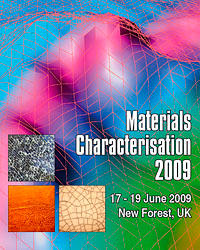 The 4th International Conference on Computational Methods and Experiments in Materials Characterisation took place recently at the New Forest Campus of the Wessex Institute of Technology (WIT). The meeting was organised by WIT, represented by its Chairman, Professsor Carlos Brebbia, and the University of New Mexico in the USA, represented by Professor Andrea Mammoli.
The 4th International Conference on Computational Methods and Experiments in Materials Characterisation took place recently at the New Forest Campus of the Wessex Institute of Technology (WIT). The meeting was organised by WIT, represented by its Chairman, Professsor Carlos Brebbia, and the University of New Mexico in the USA, represented by Professor Andrea Mammoli.Materials science in recent years has undergone rapid development in part as a consequence of advances in our ability to control and design at very small scales. Nanotechnology for instance is seen as the new frontier in materials, with the promise of performance and end functionality for exceeding today’s standards. Many ‘conventional’ materials are also benefiting from improvements in our ability to characterise them and better understand their behaviour, often leading to incremental performance enhancements. Characterisation has, by necessity, kept pace with the development of new materials. In many cases, the characterisation of complex behaviour is made indirectly by the use of a model coupled with experimental data. In other cases, physical testing provides data to tune model parameters.
The first part of the conference was dedicated to the interaction between computational models and experiments. Other sessions discussed a range of classical testing methods applied to innovative materials and composites, new testing methodologies, and two sections dedicated to cement and construction materials.
Many of the challenges that face society as a consequence of diminishing resources, especially energy, will be partly met by better materials, which ultimately should be designed and used with sustainability in mind. These challenges were also discussed during the meeting.
Opening Address
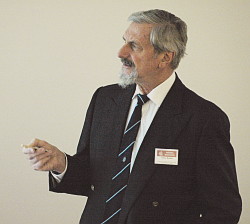 Professor Carlos Brebbia opened the meeting by welcoming the delegates to the WIT Campus and explaining the activities that take place there, with particular reference to the objectives of the Institute to act as a mechanism for transfer of knowledge. Professor Brebbia stated that as the Institute evolves, its fields of interest and interaction with other disciplines have expanded. WIT is now working as a partner in large problems involving humanities disciplines as well as engineering and sciences. This, Professor Brebbia said, is the only way forward to solve the problems facing our society and it is important to create mechanisms for the different stakeholders to communicate. In accordance with this policy, WIT has carried out research on environmental, ecological and health related problems. In all those cases, WIT’s collaboration involves modelling and computational skills for which the Institute is known throughout the world. The originality in these cases is to be able to apply these methods to the solution of new problems.
Professor Carlos Brebbia opened the meeting by welcoming the delegates to the WIT Campus and explaining the activities that take place there, with particular reference to the objectives of the Institute to act as a mechanism for transfer of knowledge. Professor Brebbia stated that as the Institute evolves, its fields of interest and interaction with other disciplines have expanded. WIT is now working as a partner in large problems involving humanities disciplines as well as engineering and sciences. This, Professor Brebbia said, is the only way forward to solve the problems facing our society and it is important to create mechanisms for the different stakeholders to communicate. In accordance with this policy, WIT has carried out research on environmental, ecological and health related problems. In all those cases, WIT’s collaboration involves modelling and computational skills for which the Institute is known throughout the world. The originality in these cases is to be able to apply these methods to the solution of new problems.Professor Brebbia referred to various trans-disciplinary projects in which the Institute is involved. They include important environmental studies, food deterioration problems, energy related studies, geophysical disaster prediction and many others.
Finally, Professor Brebbia described the different publishing activities of WIT Press and in particular the new initiative of distributing books in digital format to reach a wider audience. Professor explained that, as different from other conferences, those of WIT produce outstanding materials which are permanently available to the international scientific community.
Professor Andrea Mammoli then addressed the participants, referring to the importance of the Conference initiated in 2003 in Santa Fe, New Mexico. That meeting was followed by one in Portland, Maine, in 2005 and the last one was held in Bologna, Italy in 2007. These were all very successful in bringing together researchers who use computational methods, those who perform experiments, and of course those who do both, in all areas of materials characterisation, to discuss their recent results and ideas, in order to foster the multidisciplinary approach that has become necessary for the study of complex phenomena.
Conference Sessions
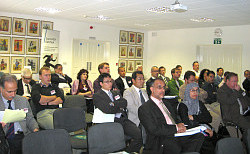 The conference sessions covered a series of interesting topics, as follows:
The conference sessions covered a series of interesting topics, as follows:- Computational methods and experiments
- Advanced materials
- Material characterisation and testing
- Porous construction materials
- Materials characterisation and testing
- New methods
- Cements
Keynote Addresses
The Sessions included a few keynote addresses:- “Identification of material properties of FRC using coupled modelling” by P. Prochazka, Czech Technical University, Prague
- “Evaluation of dynamic connection designs for road safety barriers” by D.A.F Bayton, CORUS, UK
- "Microstructural characterisation of porous construction materials – major challenges” by A.J. Klemm, Glasgow Caledonian University, Scotland, UK
- "Ultra-high-performance fiber reinforced concrete: an innovative solution for strengthening old R/C structures and for improving the FRP strengthening method” by A.G. Tsonos, Aristotle University of Thessaloniki, Greece
- “Experimental confirmation of some aspects of the microstructural model of the impedance spectra of porous materials” by I. Sanchez, University of Alicante, Spain.
Special Session by Dr Agnieszka Klemm
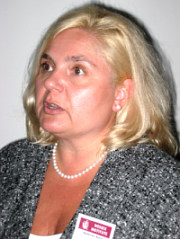 The programme included a Special Session organised by Dr Agnieszka Klemm, Reader in Construction Materials at Glasgow Caledonian University. There she is responsible for carrying out research in the type of novel building materials that are becoming widely used in construction, particularly when trying to raise their environmental and ecological impact.
The programme included a Special Session organised by Dr Agnieszka Klemm, Reader in Construction Materials at Glasgow Caledonian University. There she is responsible for carrying out research in the type of novel building materials that are becoming widely used in construction, particularly when trying to raise their environmental and ecological impact.
The session comprised the following papers:
- “Microstructural characterisation of porous construction materials – major challenges” by A.J. Klemm, Glasgow Caledonian University, Scotland, UK
- “Surfology: concrete surface evaluation prior to repair” by L Courard, University of Liege, Belgium
- “Development of new approaches to moisture content measurement for building materials” by P.H. Baker, Glasgow Caledonian University, Scotland
- “Cement-based composites for structural use” by G. Moriconi, University de la Marche, Italy
Excursion
The delegates had numerous occasions to meet outside the conference sessions. A special lunch-time excursion was organised during the first day of the meeting to a local Museum and place of interest on the Beaulieu River, called Buckler’s Hard. Ships were built in Buckler’s Hard for nearly 100 years and launched directly into the river. Henry Adams, a famous master builder, was appointed in 1749 by the local Lord of the Manor, to create a shipyard. At its height, there were five shipways and around 20 cottages for the workers. Only two rows of cottages now remain; at the end of one of them stands a hotel which was the master builder’s house. An excellent display at the entrance of the village describes the activities that took place.
Many fine ships were built there, including the famous Agamemnon, commanded by Nelson during the siege of Calvi, in which he lost the vision of his right eye. This ship, together with Swiftsure and Euryalus, all built at Buckler’s Hard, took part in the Battle of Trafalguar. In 1818, the construction of ships ceased, mainly as a consequence of the enterprise having over-extended itself. Adams had been contracted to build ships simultaneously but was unable to deliver them on time to the Navy and the resulting fines and litigation destroyed the business.
International Scientific Advisory Committee Meeting
The International Scientific Advisory Committee (ISAC) met during the conference to discuss ways in which the meeting could be improved in 2011. Several ideas were put forward, including the importance of nano-material developments, composites and the importance of considering the whole of the material life. The high quality of the conference papers and the seniority of the participants offered the possibility of widening the membership of the committee. Several names were put forward and Professor Brebbia will approach them to find out if they wish to serve on the ISAC. As usual, a series of possible locations for the 2011 meeting were proposed and discussed. WIT will investigate these with a view to obtaining a good deal for our delegates.Conference Dinner
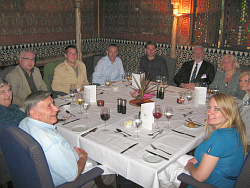 The conference dinner took place in a well known New Forest hotel called Rhinefield House. This was originally one of the lodges of the Master Keeper and later became the residence of the Forest Nurseryman, who created an ornamental drive and planted many trees in the grounds. At the end of the 19th century this lodge was sold to the Walker family, whose only daughter married a Royal Navy Officer called Munro in 1887 and the couple adopted the name Walker-Munro. They then demolished the original lodge and started building a large new house.
The conference dinner took place in a well known New Forest hotel called Rhinefield House. This was originally one of the lodges of the Master Keeper and later became the residence of the Forest Nurseryman, who created an ornamental drive and planted many trees in the grounds. At the end of the 19th century this lodge was sold to the Walker family, whose only daughter married a Royal Navy Officer called Munro in 1887 and the couple adopted the name Walker-Munro. They then demolished the original lodge and started building a large new house.The most impressive room in the house is the great hall with a hammer-beam roof resembling that in Westminster Hall in the Houses of Parliament. In keeping with the variety of styles in the house, the dining room is beautifully panelled with a large carving on the mantelpiece representing the defeat of the Spanish Armada. Other smaller rooms are decorated in Italian and French styles, the most surprising being the Alhambra room.
The conference dinner took place in the Alhambra Room, a smoking room, inspired by the Alhambra Palace. The walls have the type of gesso work associated with Mudejar architecture. Below this the walls are covered in beautiful Moorish tiles. A mosaic floor and onyx columns add to the lightness of the room. On the dome itself Stars of David made with Venetian glass can be seen. The feeling when sitting in the room has been likened to being shut inside a jewellery case.
There the participants had an excellent dinner accompanied by good wines; at the end of which the Conference Chairmen expressed their appreciation to them for attending the conference and visiting the Wessex Institute. They were given a ceramic bowl specially made by a local potter for WIT visitors.
The success of the conference will ensure that the meeting will be reconvened in 2011, the date and location to be decided shortly.
Publication of Papers
 The proceedings of Materials Characterisation IV – Computational Methods and Experiments, 464pp (Print ISBN: 1-84564-189-4-; Online ISBN: 1-84564-366-9; Print ISSN: 1746-4471) are available from WIT Press priced at £176/US$317/€229. Orders can be placed by telephone: +44 (0) 238 029 3223, fax: +44 (0) 238 029 2853, e-mail: This email address is being protected from spambots. You need JavaScript enabled to view it. or via the WIT Press web site at www.witpress.com.
The proceedings of Materials Characterisation IV – Computational Methods and Experiments, 464pp (Print ISBN: 1-84564-189-4-; Online ISBN: 1-84564-366-9; Print ISSN: 1746-4471) are available from WIT Press priced at £176/US$317/€229. Orders can be placed by telephone: +44 (0) 238 029 3223, fax: +44 (0) 238 029 2853, e-mail: This email address is being protected from spambots. You need JavaScript enabled to view it. or via the WIT Press web site at www.witpress.com.
Papers from the conference will also be hosted online at the WIT eLibrary as Volume 64 of WIT Transactions on Engineering Sciences (Online ISSN: 1743-3533). For more details visit the WIT eLibrary at http://library.witpress.com.
Patagonia a forgotten land – from Magellan to Peron, by C.A. Brebbia, 384 pp (ISBN 978-1-84564-061-3) is available in hard back from WIT Press, priced at £33/US$59/€49.50. Orders can be placed as above.
The New Forest: A Personal View, by C.A. Brebbia, 128pp (ISBN 1-84564-145-0) is available in hard back from WIT Press, priced at £19.50/US$39/€26. Orders can be placed as above.


 Wessex Institute
Wessex Institute